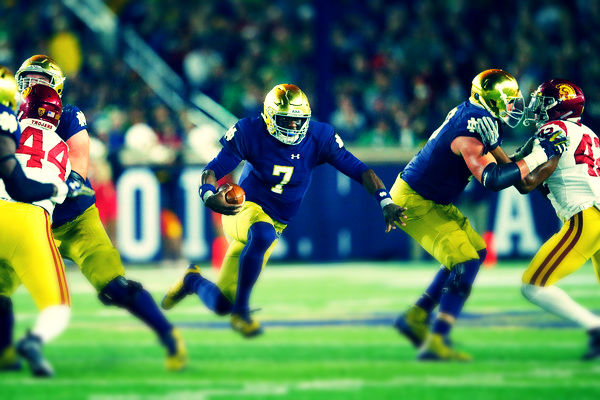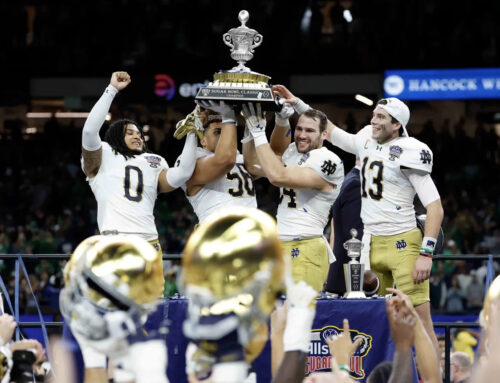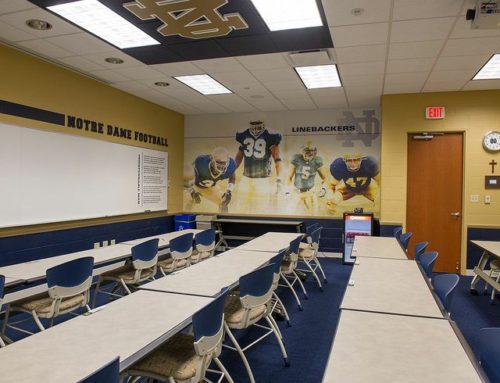Notre Dame’s offensive line won the Joe Moore Award as the best unit in the country yet gave up 30 sacks which was the most during the Brian Kelly era and an underwhelming tied for 87th in the country. What gives? How could a very good running team–and traditionally one of the top pass protecting lines in the nation–allow so many sacks?
Quick aside, the official season stats from the university lists only 29 sacks given up and that’s because they missed the lone sack from the Boston College game.
Like most of the season, things were fine until the Miami game. In charting the sacks from the beginning of the season it didn’t seem like there would be enough games for 30 sacks! Nearly half of the season sacks (14) came in Notre Dame’s 3 losses, 18 sacks came in only 4 games, while the Irish gave up 15 sacks in the 3 non-Navy games to finish the regular season. This is all in line with our other research that indicated the trickle down effect from opponent scouting on Wimbush, injuries, and some good defenses giving the Irish offense problems late in the season.
Moving on, there wasn’t any particular harmful down for the Irish. They gave up 11 sacks on first down, 9 on second down and 10 on third down.
It can be tricky to assign blame when surveying the entire line but in cases where it’s cleary possible I charted Nelson, Mustipher, and Bivin with 1 sack allowed, Kraemer with 2, McGlinchey and Bars with 4, and Hainsey with 5 allowed.
***
The knock on Mike McGlinchey was that he was prone to a handful of really big errors and that’s completely evident when looking back at the sacks. Of course, many will remember the game-winning sack by Georgia when McGlinchey got beat. There were also a couple other ugly moments.
Late in the game down in Miami it appears McGlinchey expects the blitzing linebacker to come at him and completely whiffs on the defensive end coming around the edge.
A theme that developed was the line not getting help from the quarterback which led to sacks but in this snap that’s not the case.
A couple games later, McGlinchey really looked poor against Stanford on a few snaps.
Granted, the Cardinal field is an absolute disgrace and McGlinchey ends this snap completely losing his footing and sliding into Wimbush. But, the initial pass-rush from the end literally takes McGlinchey off his feet.
For the most part, the interior of the line was really solid. You’d expect most of the sacks to come from the edge but in total Nelson at left guard and Mustipher at center really fared well in pass protection. I was particularly surprised by Mustipher who really hadn’t shined in our last film review but comes away quite effective in today’s post.
Alex Bars was a little more shaky.
At times, he struggled a little bit with the speed from opponents which is a little concerning considering Bars played tackle in 2016 and should have a good handle on quicker defenders.
This was a 3rd & long with Bars getting a clean one-on-one battle. He knows pass protection here is super important and has to do a better job giving Wimbush more time to get the ball down field.
Another interesting aspect to this research was how often tight ends were on the field (not unusual) and how often they didn’t block (a bit unusual). From the 30 sacks only one was given up by a tight end late in the Stanford game by Durham Smythe. It’s kind of a chicken or egg argument, but if you’re giving up sacks that means you’re intending to pass the ball which means typically you want to throw to your tight ends. Be that as it may, it might be a good idea for the tight end position to block more on passing downs–if the Irish wideouts can get open.
Here in the very first game of the season, with a true freshman right tackle getting serious reps no less, there are 2 tight ends next to Hainsey and not even a little help to chip a defender!
Neither Hainsey, Bars, or Adams cover themselves in glory on this snap. Was it a bit of switching off with a late lead against a weaker opponent?
It’s still flat out amazing to me that Hainsey played as much as he did for his age. It’s really not fair to him when he had some of the worst whiffs on the season because, well, his teammate 4 years his senior was just picked 9th overall in the NFL Draft and had his own bad mistakes.
Hainsey is such a curious case because he’s under-sized for a tackle, was praised for being a very good pass blocker, and at least in the 30 sacks didn’t look as strong to me as Kraemer on the edge.
You wouldn’t expect Hainsey to get beat by pure speed like this which makes me believe after failing an audition at left tackle this spring he’ll ultimately be an interior guy later in his career. I know a lot of people except him to be a candidate to start at center for 2019-20 and I can see it, honestly.
Even the best linemen can’t block forever, and holding on to the ball too long was a pretty significant issue for both quarterbacks. On 8 of the sacks I thought there was egregious enough lacking of an eternal clock from the quarterbacks. A few more were pretty close calls.
Now, in many instances these are quality coverage sacks from the defense. Still, there’s an art to throwing ‘good’ incompletions that are safely away from your opponent and/or taking off with your feet at the right time to avoid sacks.
One of the reasons why the 30-sack number on the season isn’t quite as devastating as it seems is largely because of Wimbush’s feet. While he holds on to the ball too long on this particular snap, his agility prevents this from being a much larger loss of yardage.
In fact, when you look at the other 4 teams across the country who also gave up 30 sacks the Irish gave up the fewest yardage by far while the others gave up an average of almost 60 more yards. This no doubt was due to Notre Dame’s quarterbacks ‘saving yards’ by scrambling closer to the line of scrimmage when they were sacked.
To continue, the quarterback’s need to make better decisions getting rid of the ball when breaking contain and scrambling outside of the pocket. I counted 4 really obvious situations where a simple throw-away would’ve saved plenty of yardage.
None were as obvious as this snap from the Miami game:
This could be a very hard habit for Wimbush to break because in many instances he’s able to scan the field and still get around the edge to gain positive yardage.
Looking toward next year, there will be a lot of pressure on Wimbush to set protections and get rid of the ball quicker and with more confidence. It might be a bit of a Catch-22, though. I think we’ll have to live with his scrambling and losing yardage sometimes if it keeps his big-play ability alive on the ground. But, with a quicker internal clock there may be fewer sacks and an increase in interceptions. That’s a trickier trade-off.
I could definitely see a scenario where Wimbush trusts his ability to throw more short and quicker passes, his protection might be worse in total, but sacks go down from 2017 and the offense ends up losing more yardage with Wimbush scrambling a little less and trying to trust his arm more often.












This is great analysis. Thanks!
Kind of hard to spin it forwarda lot though, don’t you think, given that Eichenberg is going to be protecting the blind side? Seems to me that is maybe the single biggest wild card hovering over the team – even more than Wimbush IMO, because at least we know we have a competent backup in Book.
I’ve felt the same way. It’s kind of hard to judge the offensive line but I’ve seen a lot of people claiming they’ll be a Top 10 (even Top 5) unit in the country which I think is tough to ask.
At the same time, it doesn’t seem crazy. They should get decent pass pro from 2 out of Eichenberg/Hainsey/Lugg at tackle. They need to get that done, at least.
Great job Eric. The O-line is one of my biggest concerns. I know we have the talent, but experience counts too.